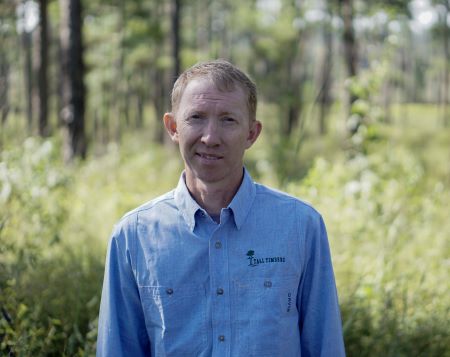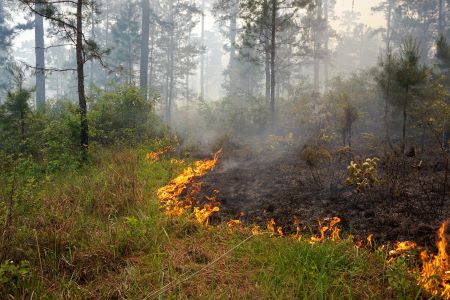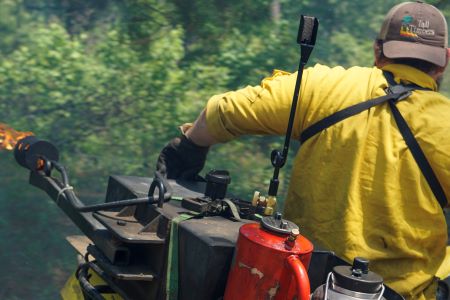Harmony in the Habitat: Quail Forever, Tall Timbers and Federal Agencies Join Forces for Quail Conservation
Quail Forever volunteers are the front line of quail-habitat preservation. Not only do they proudly get their hands dirty when it comes to land restoration, but local chapters harness the power of their community to funnel resources into the national organization in support of conservation through lobbying, education, and relationships with government and non-government agencies, which all get behind the common goal of safeguarding quail through methodical land stewardship.
Several of Quail Forever’s go-to partners are the U.S. Department of Agriculture’s Working Lands for Wildlife (WLFW), Conservation Reserve Program (CRP), Natural Resources Conservation Services (NRCS), as well as the non-profit organization Tall Timbers. Tall Timbers pioneered prescribed burning to promote healthy quail landscapes, beginning in its own backyard of the legendary bobwhite quail belt called the Red Hills Region that encompasses North Florida and South Georgia.

“Tall Timbers and Quail Forever are important mediators in connecting private landowners and government agencies to create positive ecological attributes to provide habitat for wildlife,” explained Dr. Dwayne Elmore, Game Bird Program Director at Tall Timbers. “Sometimes the landowners need technical help on the land side and financial assistance on the government side. Tall Timbers and Quail Forever are collectively trying to get landowners into these programs. From the landowners’ perspective, it’s a lot of work to figure that out by themselves.”
By forging these relationships, Quail Forever can leverage complementary know-how and funding. When it comes to boots on the ground, though, Quail Forever’s regional biologists are the folks who often make things happen in the management and implementation of these collaborations. As facilitators, it’s the biologists who channel crucial technical guidance and partner resources to assist landowners who often find it daunting to undertake projects by themselves involving the restoration of grasslands for food, cover and nesting that complies with state and federal regulatory agencies. And even when these programs are actually put into place, the involvement of Quail Forever biologists plays a crucial role in continuing observation and research for measuring real-world results.
At Quail Forever, biologist Dr. Jessica McGuire is a Senior Wildlife Program Manager based in Dawson, Georgia. She describes her job as the coordinator across 25 states with the USDA.
“We work with them through the Farm Bill,” she explained. “About 75 percent of our biologists are funded through the USDA’s Environmental Quality Incentive Program.”
She’s also part of a team that includes the WLWF focusing on grasslands and savannahs throughout the Southeast. “The USDA supplies the funding and we implement the program by working with farmers and other private land owners to make the program a success,” she said.

(Photo: Brian Wiebler)
Her coordination within the USDA is far reaching for the Farm Bill Program. To get the job done, she’ll also tap into the USDA’s Natural Resources Conservations Services and Farm Service Agency.
“Working with NRCS and FSA lets us help landowners incorporate wildlife practices into their production,” she said. “It might be a pollinator planting such as Indian flower or Black-eyed Susans, or something to fend off invasive species like privet. We’ll plant field borders at the edge of a cotton field so the quail can hide from predators. We have about a fifty-fifty split of landowners who have been enrolled in programs before and it’s their first time using these federal programs in a new way, and others who have never participated before. We’ll put up posters in coffee shops and Tractor Supply to let people know what we’re doing. Our chapters are a good place where we get the word out for promoting wildlife.”
When it comes to landowner outreach, cooperation between the organizations really pays dividends. Case in point, at the 2024 National Pheasant Fest & Quail Classic, Dwayne delivered a presentation in a technical session organized by Quail Forever that involved prescribed fires. He provides oversight and guidance for all game-bird projects across the Southeast.
“Some of our folks get more involved to collaborate with Quail Forever to get prescribed fires on the landscape,” he explained, illustrating how shared research benefits both organizations and the landowners they serve. “We know a lot of folks at Quail Forever.”
Dwayne is a big believer in overstory thinning and frequent burning. He considers them “two big first steps” for landowners interested in supporting bobwhite quail. The thinning and burning are the foundations from which landowners set their sights on management goals.
In terms of government funding, Quail Forever, Pheasants Forever and Tall Timbers receive federal grants from the Regional Conservation Partnership Program. The RCPP awards originate from the NRCS.

(Photo: Brian Wiebler)
As it turns out, both Dwayne and Jessia have family farms in Georgia that have received awards from the NRCS for habitat restoration. Jessica raises cattle and pigs for meat production. Dwayne and his wife, who is also a wildlife biologist, help manage around 300 acres of a 650-acre farm as part of a 30-year restoration project that started with his mother-in-law in the 1990s.
“We do a lot of positive things for quail,” here he said, adding that Tall Timbers and Quail Forever are collectively trying to get landowners into similar programs.
Instead of growing a commodity like peanuts, Dwayne and his family use controlled burns to foster the growth of pine trees – letting gopher tortoise and quail thrive. “These federal programs help people like us take land out of production and so that it’s not all out of pocket,” he said. “We couldn’t do a lot of this work if we didn’t have cost-share help.” It’s allowed the family to hunt quail on their property.
Then again, sometimes it just comes down to lining up a burn team for smaller landowners who don’t have their own or have difficulty competing with larger properties to find independent contractors.

Tyler Macmillan, Tall Timbers’ Conservation Program Liaison for NRCS, talked about how they developed a cost-share program “to defray burning costs on smaller properties of several hundred acres. That’s how we try to get landowners onto a two-year burn rotation.”
Tyler also explained how Tall Timbers developed the regional Prescribed Burn Association. “That’s neighbors helping neighbors with Tall Timbers helping organize it, but also training land owners how to burn to the point where they call their friends and organize a burn.”
Tyler points out that Quail Forever has similar programs. For example, in Georgia Quail Forever has a number of Farm Bill biologists “that essentially do the same thing. You figure out landowner’s goals, and develop a plan that drives the cost-share funding.”
In the face of declining quail populations due to changing farm practices, predation, and real-estate development, sharing a common goal with like-minded groups is not an option, but an imperative. By working together, habitat leaders such as Quail Forever, Tall Timbers and federal agencies can combine their respective strengths and resources to maintain and expand healthy quail habitats.
Irwin Greenstein is the Publisher of Shotgun Life. You can reach him on the Shotgun Life Facebook page at https://www.facebook.com/shotgunlife
Helpful resources:

Irwin Greenstein is Publisher of Shotgun Life. Please send your comments to letters@shotgunlife.com.


Comments